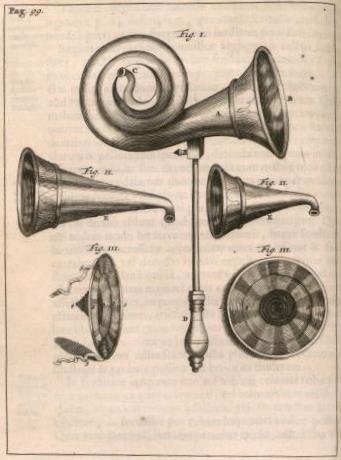
We might take it as a given that our hearing aids are barely noticeable, can be managed with our cell phones, and can discern between speech and background sound. What we may not recognize, however, is that those features are the products of 400 years of experiment, design, and refinement.
Even 5 years ago, hearing aids could not deliver the clarity of sound generated today. To see why, let’s track the history of hearing aids—beginning today and going backwards—to see how hearing aids would have treated your hearing loss in four different years: 2016, 1985, 1940, and 1650.
2016 – Contemporary Digital Hearing Aids
It’s 2016 and you’re searching to treat your hearing loss. You open up a web browser, search for a local hearing care professional, fill out a brief form, and arrange a consultation.
At your hearing test, your hearing is analyzed using state-of-the-art computer technology that precisely measures your hearing. Then, with the help of your hearing practitioner, you select a hearing aid that suits your requirements from a vast selection of models.
Then, your hearing specialist programs your new hearing aids to magnify only the sounds and frequencies you have difficulty hearing, producing crystal clear sound without distortion.
If you were to tell anyone in the 1980’s that this would be the process, they wouldn’t have believed it was possible.
So what did make it possible? In short, digital technology.
For most of their history, there was no way for hearing aids to discern between different sound frequencies. Hearing aids would magnify all incoming sound, including background noise, generating distorted sound.
The digital revolution addressed that issue. With digital technology, all information can be converted, stored, and manipulated as combinations of 0’s and 1’s. Digital technology permitted hearing aids to convert sound frequencies into digital information, which could then be classified according to which sounds should be amplified (speech) and which should be suppressed (background noise).
The first all-digital hearing aid was manufactured in 1995, and since that time the technology has improved significantly, eventually to include wireless functionality.
1985 – Transistor Hearing Aids
Now, imagine it’s 1985 and you’re planning to treat your hearing loss. You can forget searching for a local hearing care provider on the web because the first commercial internet service provider won’t be established until 1989.
You’d have to use the yellow pages, rely on recommendations, or drive around the neighborhood to find a hearing care practice.
After scheduling an appointment and having your hearing tested, your choices for hearing aids are very restricted. Without the microprocessor and digital technology, hearing aids were manufactured with a collection of transistors. This adds size and higher power requirements, resulting in bigger batteries and massive hearing aids.
Additionally, without the advantage of digital technology, the hearing aid can’t distinguish between various frequencies of sound. Hearing aids receive incoming sound and the transistors behave as basic amplifiers, amplifying all sound. So if you’re in a loud area, speech recognition will be nearly impossible.
1940 – Vacuum Tube Hearing Aids
It’s 1940 and you’re contemplating acquiring a hearing aid. Transistors haven’t been applied to hearing aids yet, so your options are limited to vacuum tube hearing aids.
Vacuum tubes utilize more power than transistors, so the hearing aids require larger batteries, making the hearing aids big, heavy, and cumbersome.
And once again, without digital technology, the hearing aids can only act as basic amplification systems, making all inbound sound louder. The hearing aids can’t enhance speech and cannot remove background noise.
1650 – Ear Trumpets
Let’s travel all the way back to 1650. There’s no digital technology, no transistors, and no vacuum tubes. That means no way to convert sound into electrical currents that can be amplified.
With electrical amplification unattainable, your only alternative is mechanical amplification by focusing and compressing sound into the ear canal, such as what takes place when you cup your hands around your ears.
By 1650, devices were developed that focused inbound sound into the ears, and these contraptions were named ear trumpets. They were prominent devices with a conical end that collected sound and a narrow end that concentrated the sound into the ear.
This would be the only technology accessible to people with hearing loss for the following 250 plus years.
Let’s return to 2016. Throughout more than 400 years of history, hearing aids have develop from mechanical amplification devices to electrical amplification devices, from vacuum-tube-based to digital-based. They’ve come to be progressively more compact, lighter, and more effective and affordable.
They’ve also become better at differentiating among various types of sound, and in amplifying only specific types of sound (such as amplifying speech while suppressing background noise).
Every generation of hearing aid has generated a major enhancement over the previous generation. The question is, what’s the next major milestone in the history of hearing aids?
Will we soon be able to improve natural human hearing, rather than simply restore it?
